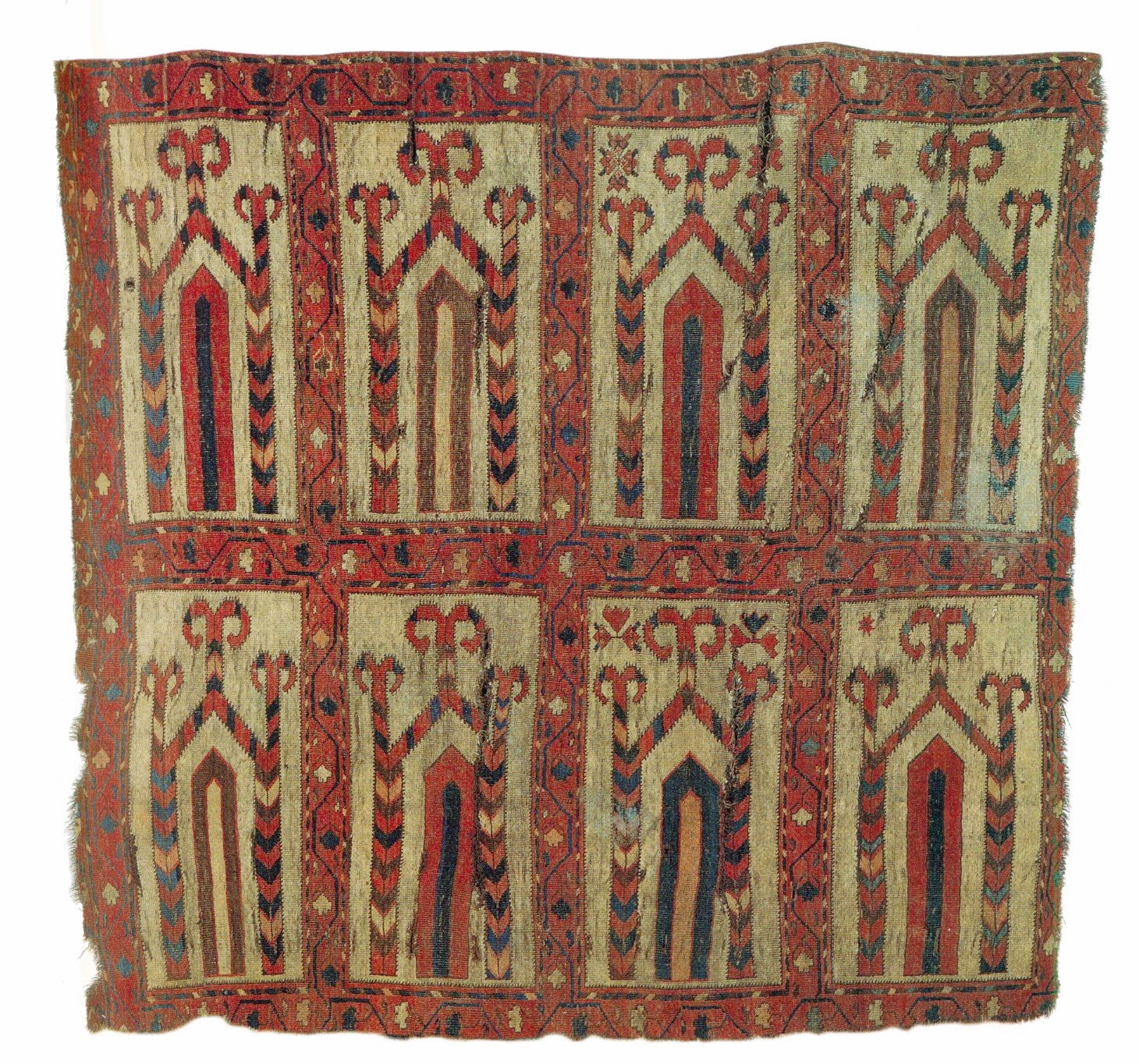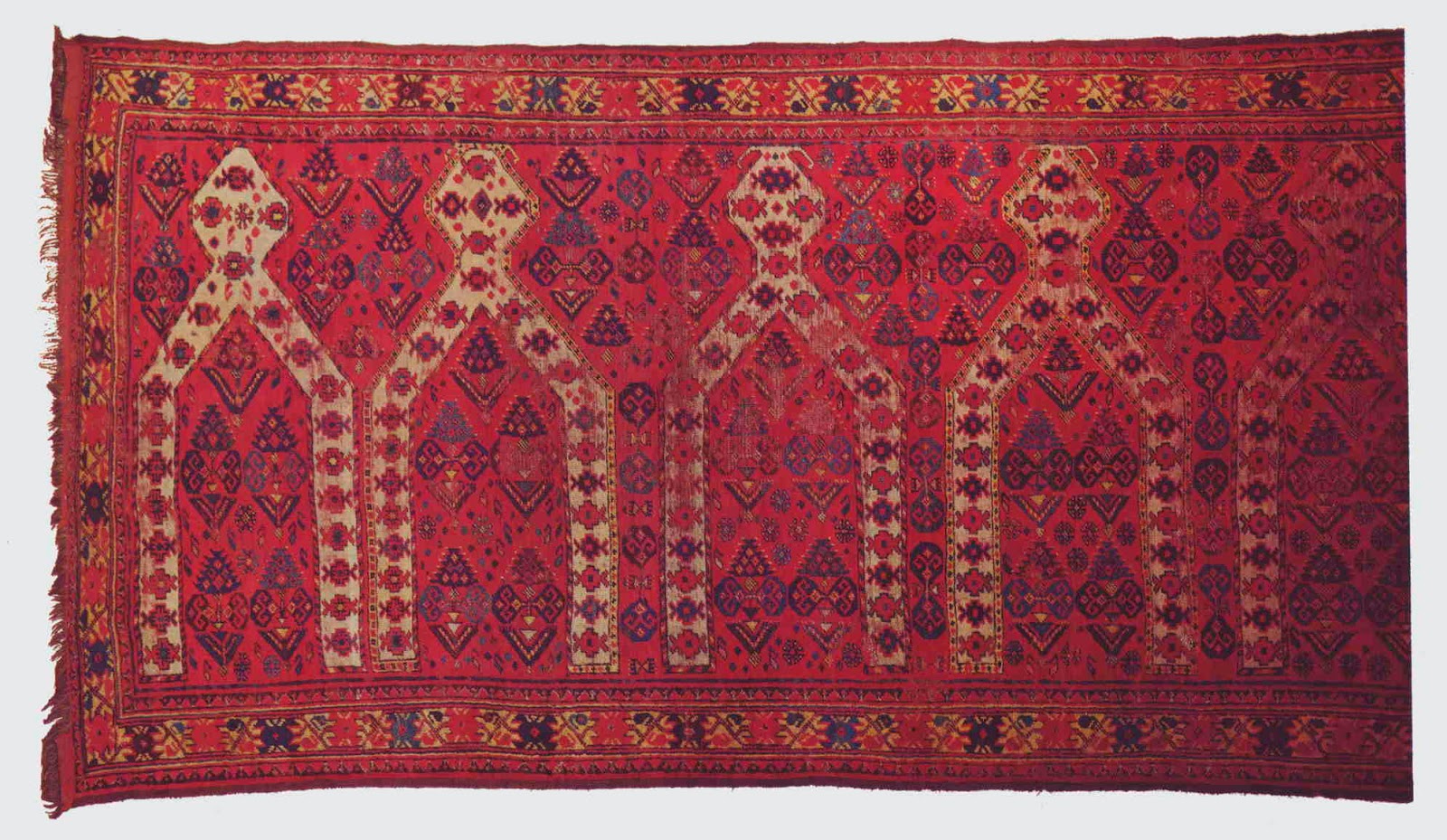Considering the business-hold that Caucasian manufacturers had on the prayer rug market in the 19th century,the lack of Saphs from the area is puzzling.Perhaps the answer lies in their concentration on small rugs: the lions-share of large carpets was held by the British and German companies working in Persia,Turkey and India.Be that as it may,very few(mostly mediocre) examples were produced,chiefly in the "Shirvan" Zone.
A carpet from the Michaelian Collection must take pride of place,having been frequently exhibited and finally auctioned at the Vojtech Blau sale in 2006 for $39,000,a price stimulated no doubt by its "Marasali" design
 |
| 80-Sothebys 14 December 1996(74) |
A carpet dated 1911 was auctioned some years before at Sothebys for $6520.Its panels feature a recycling of standard designs
 |
| 81-Sothebys 2 May 2001(25) |
A very similar example was sold earlier still at Christies London for 3,240 pounds
 |
| 82-Christies 25 October 1984(26) |
A carpet with Maktabi featured the classic 5 panel format mostly commonly encountered in Caucasian saphs,and a weave typical of Talish rugs
 |
| 83-Hali 115-137 |
Similar in feeling was a piece auctioned at Christies for $4,200,as "Genje"
 |
| 84-Christies 23 June 2006(81) |
Two later Southern Caucasian weavings share a similar design.The first was published in "The Treasure of the Caucasus" in 1993
 |
| 85-Keshishian Collection |
A second example was with the German-Turkish dealer Sari in Karlsruhe
 |
| 86-ebay 2008 |
Another Internet appearance was made by a rare example with Lesghi star
 |
| 87-S.Ahmet |
A last example with recycled designs is in a Russian collection
 |
| 88-Moskova |
PERSIA
Little is known about traditional mosque fittings in Persia.It is claimed that zilus,flatwoven items chiefly held in blue and white,were formerly used.Few have survived,but some are apparently of great age as an example in the Hermitage museum shows,which is dated to the 14th century
 |
| 89 |
Parviz Tanavoli illustrates a Zilu Saph
 |
| 90-Persian Flatweaves(196) |
A photograph from Jon Thompson shows their use
 |
| 91-Thompson,Timbuktu(3.6) |
Yet the final balance of knotted rugs is meagre.Only four pieces are known,mostly of venerable age,and nothing from the 19th century.A salient example,divided between four collections,is one of the most beautiful of all known Saphs,and a highpoint of Safavid weaving(although sometimes ascribed to India)Michael Franses has argued that it was a gift of Shah Tahmasp to the Ottoman Sultan Suleyman.The largest piece is said to have come from the Suleymaniye Mosque,although there is no proof of this.Just why the Sunni Sultan would want to place a carpet from a Shia monarch in his new Mosque is not clear.The Saphs previously examined in the Turkish section are stylistically world`s apart from the Classic Safavid patterning,but do echo the spirit of the Ottoman Society.The Persian carpet would surely have seemed out of place.Be that as it may,the four fragments were all at one time in Istanbul.One large piece is still in the TIEM,the others are in Berlin,Kuwait,and the former Wher Collection.The rhythmic patterning varies from row to row,alternating between medallion field and arabesque.The arabesque is not unlike that found on the Stora carpet,the smaller version of the Ardabil,with a counterpoint of large lotus leaves and small palmettes
 |
| 92-The Stora Medallion Carpet,Keir Collection |
 |
| 93-Kuwait |
An attribution to North-west Persia,on technical grounds,seems clear.The carpet was woven in a non-perpendicular style,thus necessitating a very large loom.
 |
| 94-Istanbul,TIEM 105,after Gans-Ruedin |
 |
| 95-Istanbul TIEM 105-Hali ICOC Istanbul guide |
 |
| 96-Istanbul |
 |
| 97-Kuwait-F.Spuhler |
 |
| 98-Kuwait |
There is a considerable difference in the duktus of the Berlin carpet`s mihrab,indicating that it may have been part of a second example
 |
| 99-Berlin-A.Beselin(135) |
A last fragment,once with Hugh Moss,passed to the Wher Collection.It resembles the Berlin fragment
 |
| 100-Grosvenor House catalogue 1973(65) |
Two Saphs have been kept at the shrine of Imam Ali at Najaf,Irak,for hundreds of years,and are presumably still there if sectarian violence has not displaced them.Local tradition has it that they were donated by Shah Abbas,and one is signed with the typical phrase,"Abbas,dog of this shrine".The carpets,a complete and fragmentary piece,are closely related,as are two further border fragments in the collection.They are woven in wool with metal thread brocading(in the ground of the mihrab and spandrels)thus locating them in the Salting group zone.Their ultimate publication in colour with full analysis will one day be a major event.
 |
| 101 |
There is more than a hint in the direction of the vase carpets with their split palmettes and Lotus whirligigs
 |
| 102-McMullan Collection |
 |
| 103 |
Leading on from the Najaf pieces are two fragments,both of which were once with Bernheimer
 |
| 104-MET,ex Ballard |
 |
| 105-Bernheimer(1908) |
The whereabouts of the second fragment are unclear.They are said to have been made in either Central or North East Iran
 |
| 106-Collage |
A well published pair of Saphs are now attributed to Khorasan.Several fragments have appeared on the market,starting with the largest,the Godard-Keshishian
 |
| 107 |
This mighty fragment first appeared at Christies London on 28 April 1995 where it sold for $47,840.It was accompanied by a corner piece which fits quite nicely in the missing corner,although it does not belong there:the indentation is thus woven,presumably to circumnavigate an architectural obstruction.The corner piece was sold as the next lot for $3680.Just why it was woven is a mystery.
 |
| 108 |
 |
| 109-The Saph with its ghost-corner |
The major whiteground border seems to have been inspired by a type seen on NW Persian medallion carpets,such as the MET`s Blumenthal
 |
| 110-MET wb-14.100-2 |
The carpet was re-auctioned at Sothebys New York,sans corner,in 2010,and this time its importance was rewarded with a sale price of $218,500.
Another large fragment,presumably a pair to the above,made a brief appearance at Boisgirard`s sale in Paris on 19 March 2004,where it was bought in against a bid of €105,000.(see hali 134-13)This was unfortunate,as it later made the same price but in dollars,at Christies London on 4 October 2011(200)It is said to have been in a Basle Collection
 |
| 111-Christies 2011 |
Interestingly,the remains of an indentation can be seen in the upper right hand corner,showing that the original carpet had been wedge-shaped(or actually,like a rectangular mihrab)Here a simple reconstruction of the two pieces together,although the originals would have faced off-not to forget the perpendicular weave with the mihrabs woven sideways
 |
| 112 |
Perhaps there exists somewhere a mosque with such a lacunae,either in East Persia or India.
Some splendid fragments exist from these carpets,including an item offered by the Textile Gallery in Hali 1-4
 |
| 113-Textile Gallery |
and a piece once with Herrmann in Munich
 |
| 114-Herrmann,ATT 1(7) |
A small fragment is in the Keir Collection
 |
| 115-Keir Collection 2(T30) |













































































